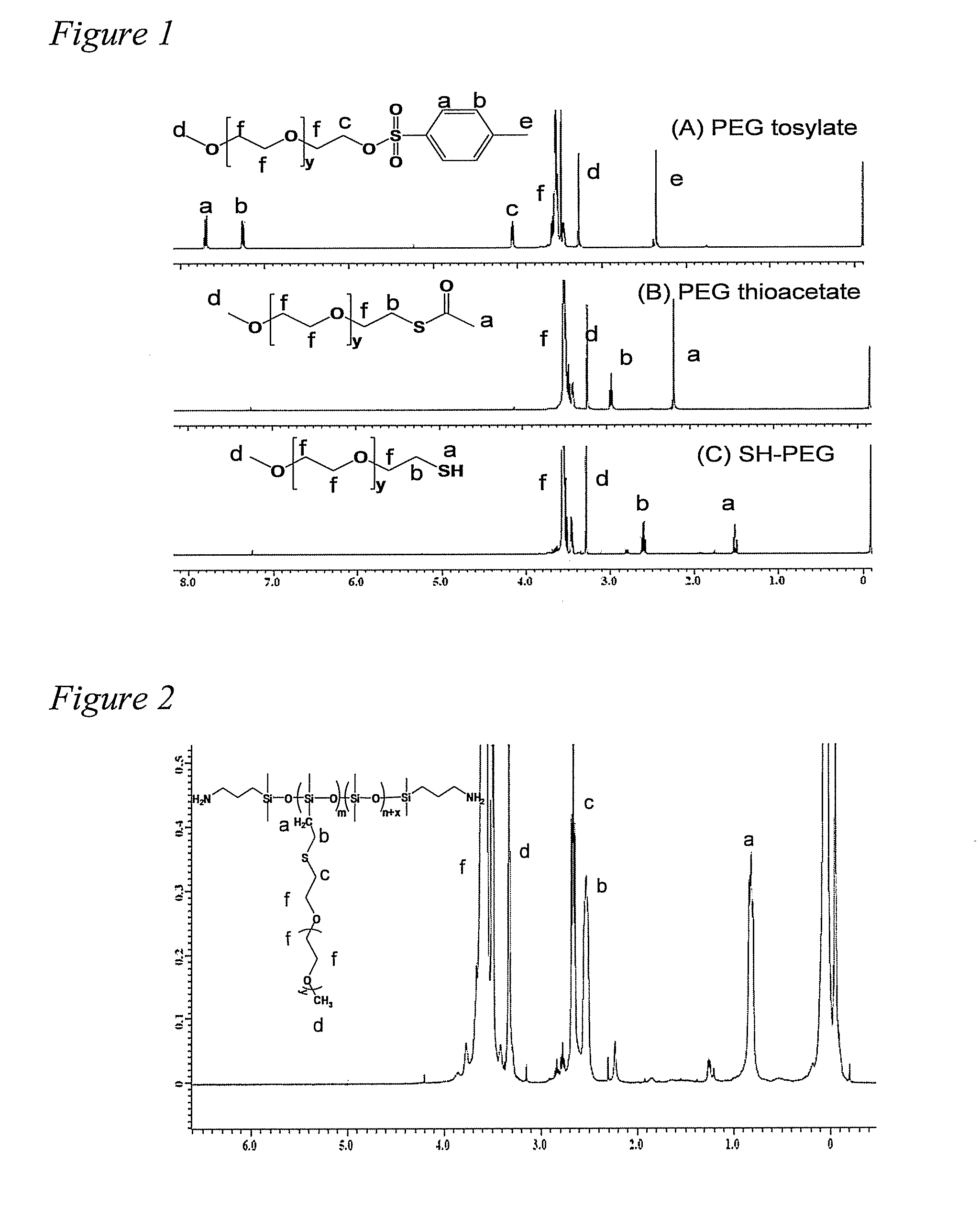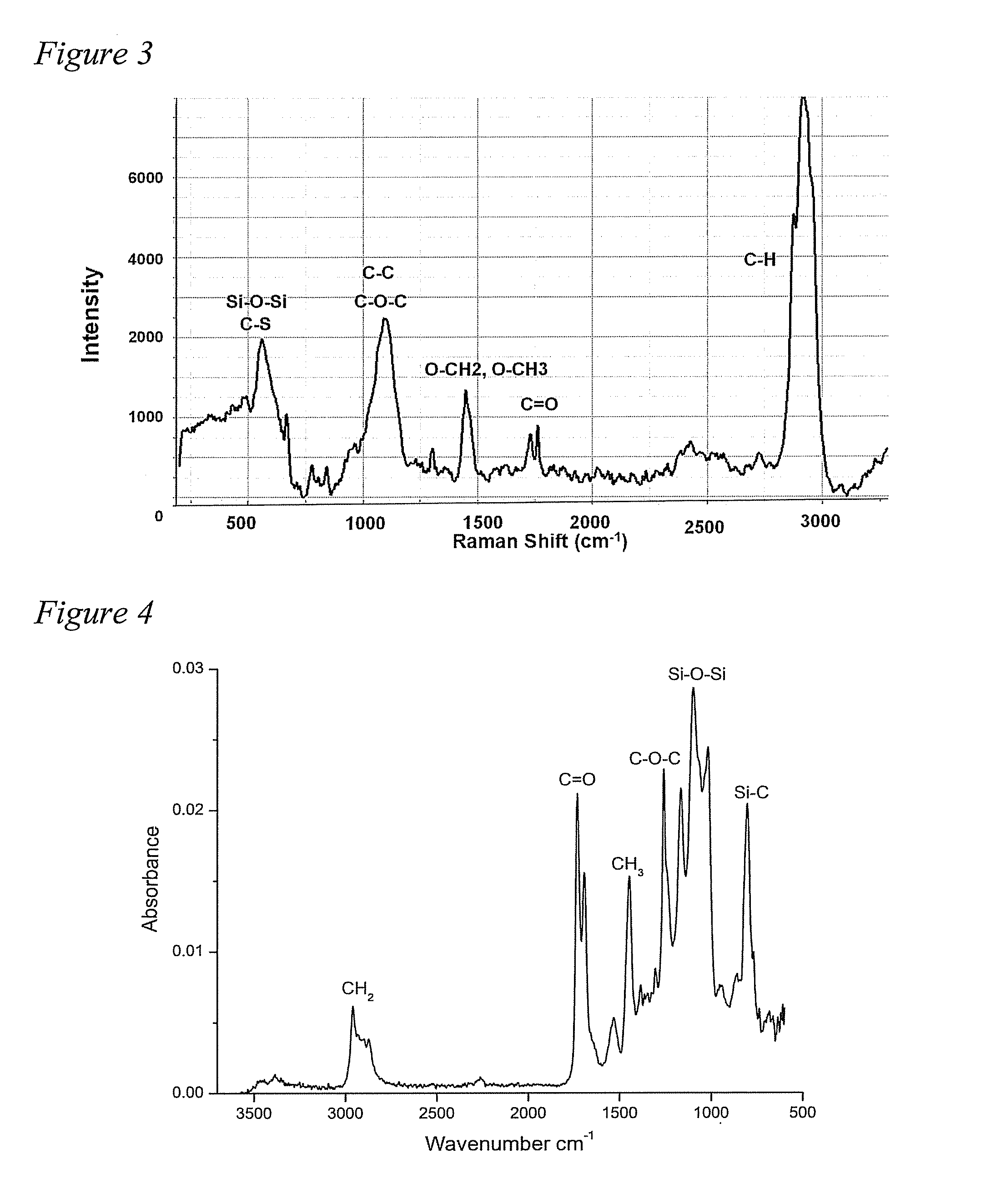Functionalized silicones with polyalkylene oxide side chains
a technology of polyalkylene oxide and silicone, applied in the direction of antifouling/underwater paints, biocides, coatings, etc., can solve the problems of sam approach not suitable for broad practical use, surface fouled rapidly, inflammation, etc., to reduce or eliminate the attachment of biological materials, reduce or prevent the effect of adhesion
- Summary
- Abstract
- Description
- Claims
- Application Information
AI Technical Summary
Benefits of technology
Problems solved by technology
Method used
Image
Examples
examples
[0068]The present invention is illustrated by the following examples. It is to be understood that the particular examples, materials, amounts, and procedures are to be interpreted broadly in accordance with the scope and spirit of the invention as set forth herein.
Introduction
[0069]Siloxane polymers with terminal amine functionality and pendant PEG chains were synthesized. Briefly, equilibration polymerization of two cyclic siloxane monomers, octamethylcyclotetrasiloxane (D4) and 1,3,5,7-tetramethyl-1,3,5,7-tetravinylcyclotetrasiloxane (D4v) was carried out, after which thiol terminated PEG chains were added across pendant vinyl groups using thiol-ene click chemistry.
[0070]The PEG grafted siloxane polymers were characterized by NMR and GPC. The polymers were then incorporated into a thermoset polyurethane (PU) system and the coatings were characterized for their surface properties using water contact angle (WCA), Confocal Raman microscopy (CRM), and Attenuated Total Reflection-Fouri...
example i
Synthesis and Characterization of 3-Aminopropyl-Terminated Polydimethylvinyl Siloxane (APT-PDMVS)
[0094]Vinyl functional APT-PDMVS was synthesized using D4, D4V and APT-PDMS-875. See Bodkhe et al., Prog. Org. Coatings 75, 38-48 (2012). In one experiment, APT-PDMVS polymer having Mn 10000 g / mole was synthesized by anionic ring opening equilibration polymerization (ROEP) of D4 and D4V. Catalyst benzyltrimethyl-ammonium hydroxide was added to D4 and methanol was removed using a rotary evaporator. Catalyst concentration was 0.1% on monomer. Rotovapped D4 solution, D4V and APT-PDMS-875 as end blocker were equilibrated for 48 hrs at 80° C. in a 250 ml 2-neck flask in the presence of nitrogen with magnetic stirring and. Then, the polymer was heated to 170° C. for 45 minutes to decompose the catalyst. The clear polymer obtained was characterized for 1H NMR and GPC.
[0095]3-aminopropyl-terminated polydimethylvinyl siloxane (APT-PDMVS) polymers having Mn of 5000 and 10,000 g / mole 1:1 mole ratio...
example ii
Synthesis of Thiol Terminated PEG (SH-PEG)
[0097]Synthesis of SH-PEG is multistep process and, under typical synthetic conditions an active thiol group can form product with poor purity. Therefore, the important step in this synthesis approach involves preparation of thiol-terminated PEG since the commercial price of SH-PEG is very high and literature regarding its synthesis is limited (Wan et al., Reac. &Func. Polym. 2008 68:431-435). The synthesis of SH-PEG is shown in Scheme 2. The hydroxyl PEG was tosylated with P-toluene sulfonylchloride to form the tosylated PEG which was subsequently changed to thioacetate terminated PEG by displacing the tosyl group. The hydrolysis of thioacetate PEG yield SH-PEG with 87% purity. The higher purity PEG was not desirable in this case since excess PEG used in thiol-ene reaction as well as non-functionalized PEG was extracted using THF and cold hexane. 1H NMR spectra of synthesis of SH-PEG showed the peaks expected to be present in the product of...
PUM
| Property | Measurement | Unit |
|---|---|---|
| size | aaaaa | aaaaa |
| pressure | aaaaa | aaaaa |
| impact pressure | aaaaa | aaaaa |
Abstract
Description
Claims
Application Information
 Login to View More
Login to View More - R&D
- Intellectual Property
- Life Sciences
- Materials
- Tech Scout
- Unparalleled Data Quality
- Higher Quality Content
- 60% Fewer Hallucinations
Browse by: Latest US Patents, China's latest patents, Technical Efficacy Thesaurus, Application Domain, Technology Topic, Popular Technical Reports.
© 2025 PatSnap. All rights reserved.Legal|Privacy policy|Modern Slavery Act Transparency Statement|Sitemap|About US| Contact US: help@patsnap.com



